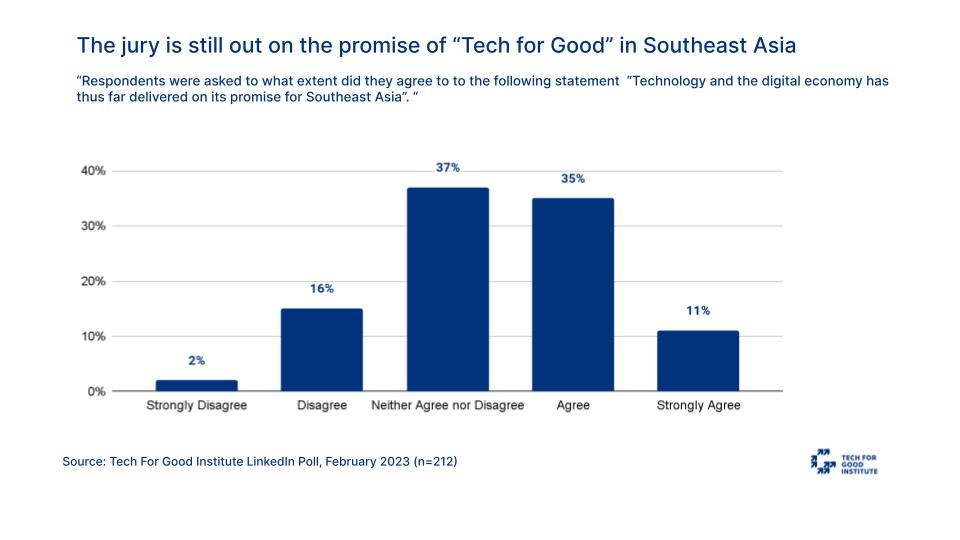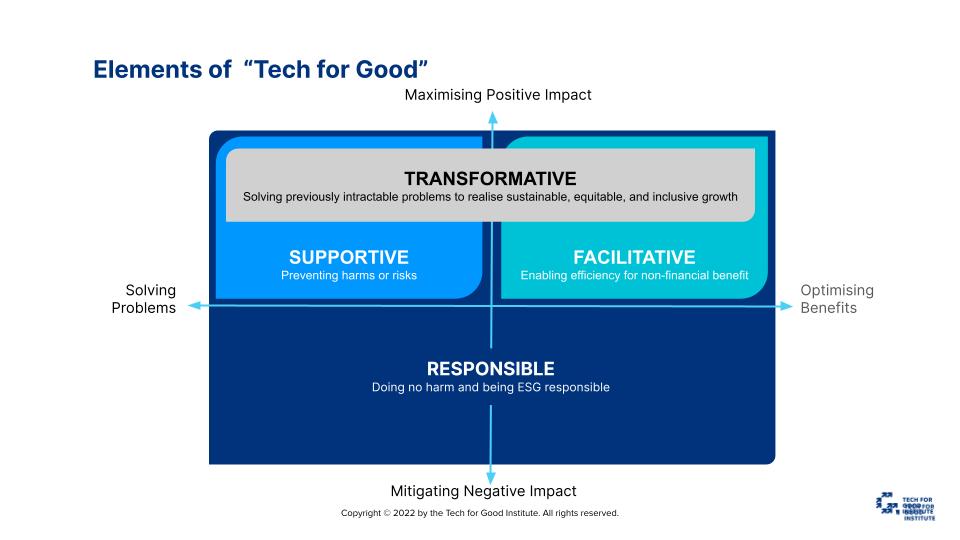
By Ming Tan, Founding Executive Director, Tech For Good Institute
“Tech for Good” is a catchy, feel-good phrase that can take on many meanings. By one account, “Tech for Good” sectors, such as health tech, education tech, clean tech, femtech, and enterprise environmental, social, and governance (ESG) software, are seeing rising investments and reached US$79 billion dollars globally in 2021. At the Tech for Good Institute, our engagements with the tech ecosystem – policymakers, regulators, industry champions, companies and civil society – have revealed a landscape of many different definitions, and hence expectations. Some consider “Tech for Good” in the service of advancing inclusivity and equity, such as assistive technology. Others may refer to “Tech for Good” when technology is deployed to improve non-financial positive outcomes, such as disaster preparedness, climate resiliency, education or healthcare. Still others may consider that “Tech for Good” has delivered when negative outcomes are prevented, as in the case of fraud detection, traffic management or predicting failure. Last but not least, some also think of “Tech for Good” as simply operating sustainably and mitigating risk.
Without a shared understanding of “Tech for Good”, it is no wonder that the jury is still out on whether technology is indeed delivering net positive impact. In February 2023, the Tech for Good Institute ran a flash poll to gauge how the concept of “Tech for Good” is currently received in Southeast Asia. Of the 212 respondents from across the Southeast Asia-6 countries: the Philippines, Malaysia, Indonesia, Vietnam, Singapore, and Thailand, only four in ten strongly agreed or agreed to the proposition that technology and the digital economy have thus far delivered on its promise for Southeast Asia. Almost as many (37%) stayed neutral.
How then, should we assess the impact of technology and the digital economy? In Bending the Moral Arc of Technological Adoption in Indonesia Towards Good, Ibrahim Kholilul Rohman and Maria Monica Wihardja usefully brought together the OECD’s Framework of Measuring the Digital Economy with seven other broad areas impacted by the digital economy, and mapped them against the United Nations’ 17 Sustainable Development Goals. Rohman and Wihardja also highlight that, like any industry, the digital economy can have positive and negative consequences on society and the environment through developing and delivering products and services.
A Framework for “Tech for Good”
At the Tech for Good Institute, we believe that digital technologies and the digital economy may drive more than economic growth, but also sustainable, equitable and inclusive development for all. Technology’s impact is a result of both the technology itself and the business model around it, which creates the use case for business and society. History is full of examples in which technology itself may be deployed for positive or negative outcomes. Nuclear technology’s devastating impact, for example, was clear when fission bombs fell over Hiroshima and Nagasaki in 1945. Governed under international treaties such as the Treaty on the Non-Proliferation of Nuclear Weapons and by international, national industry regulatory bodies, however, nuclear technology has since been deployed across multiple commercial sectors, most notably in medicine.
Given the wide potential scope for Tech for Good, we developed a simple visual representation of how different approaches may deliver on technology’s promise.
The vertical axis applies to whether the full social and environmental cost of technology is considered (bottom half) and the degree to which non-economic benefit to society and the environment is realised (top half). Using nuclear technology as an example, significant effort is needed to ensure safety in production, handling and disposal. The needs of the community, environment and future generations must be taken into consideration as radioactive material can remain hazardous for many lifetimes. Only after the full costs and negative consequences are addressed may technology be considered to be delivering net positive impact.
The horizontal axis highlights how the digital economy may add or create value on top of economic growth through digital products or services. Since all digital technologies share the common ability to collect, store and manipulate data quickly, accurately and at a scale, this processing power may be deployed to prevent risks and harms to society or the environment (left), or to enable efficiency to meet social or environmental objectives such as increasing access, improving accuracy, reducing error or lowering cost (right). Some digital technologies and their applications can also create whole new approaches to achieving non-financial positive impact, as indicated in the top layer. Extending the example of nuclear technology, its impact in medical imaging and diagnostics has transformed the entire field of medicine.
With this framework, we are able to better articulate the different ways in which digital economy companies may realise the concept of “Tech for Good”:
- Responsible tech seeks to simply do no harm. Responsible digital economy companies examine their systems, processes, products and services to identify and mitigate negative consequences. This applies to both the upstream development and downstream impact of products and services. Digital technologies can be inherently values-driven, so upstream considerations include developing systems with inclusion, security and data protection baked into the design, while maintaining a transparent posture to build trust. For example, developers can intentionally ensure that datasets used to train algorithms are not biased. Conscious decisions can be made to determine if systems should be designed for frictionless data sharing or systematic data protection. Downstream considerations include the social and environmental impact of the production, use and disposal of technology, maintaining consumer choice, protecting livelihoods, and ensuring health and mental wellbeing of users. With digital technologies evolving so rapidly, operating responsibly is a moving goalpost. As regulators turn their attention to sectors and activities within the digital economy, the business case for mitigating the negative consequences of operations can be as straightforward as maintaining a licence to operate. In our poll, only 14% of respondents thought that responsibility alone constituted “Tech for Good”, suggesting that sustainability is necessary but not sufficient.
- Supportive tech not only mitigates its own negative consequences, but enables positive outcomes through new ways of preventing harms and risks. To give three examples: automated safety systems in vehicles or manufacturing can reduce accidents or loss of life. Sensors and satellites, together with data collection, processing and modelling, have greatly enhanced weather monitoring and forecasting to improve response to severe weather events. Cybersecurity applications use predictive AI models to identify vulnerabilities and pre-empt cyber-attacks.
- Facilitative tech, on the other hand, optimises benefits by increasing efficiency. The benefits are realised through streamlined processes, time saved, improved convenience, increased access, reduced waste or lower cost. For example, online to offline platforms, which match supply and demand for services, enable new livelihood and income opportunities while enabling convenience for consumers. Other examples of facilitative tech include the use of data analytics to support decision making, automation for repetitive tasks to reduce manual labour and minimise errors, and communication technology to enable collaboration across geographies.
- Transformative tech not only realises net positive social or environmental impact at scale, but tackles global, national or local challenges in whole new ways. Transformative products, services and business models radically transform lives and livelihoods, while solving the world’s most complex problems. As a result, transformative tech tends to be disruptive, creating new industry sectors or reinventing existing ones. The fintech sector is one such example. Access to financing has long been difficult for micro, small and medium-sized enterprises (MSMEs). While simple physical inaccessibility to banks is one factor, gaps in formal documentation and the lack of collateral also make it challenging for many MSMEs to access credit from traditional sources. Today, digital financial services providers such as Grab Financial Group, SEA Money and Goto Financial can use alternative sources of data such as transaction data to develop credit risk models for those with no collateral. The Tech for Good Institute found that over 70% of digital lending users had previously been unable to secure financing from banks and other lenders. By reaching and serving customers digitally, these providers can also offer micro-financing products and reduce the cost to serve its customers, enabling further affordability of their products and services. Another example of transformative tech would be the use of light detection and ranging (LiDAR) sensors as an alternative to field-based estimates for mapping and monitoring forests for carbon stock monitoring. Such verifiable data facilitates trust in new carbon markets, supporting the global effort to reduce carbon dioxide.
This framework is, of course, not mutually exclusive. Supportive, facilitative and transformative tech must also be responsible, and transformative tech is usually a subset of supportive or facilitative approaches to closing shortfalls to society or addressing unsustainable demands on the environment.
The Tech for Good Institute’s February 2023 poll suggested that “Tech for Good” was most often associated with Transformative impact. Seven in ten respondents associated “Tech for Good” with driving transformative impact and solving complex societal problems; far fewer thought that optimising efficiency and preventing harms constituted “Tech for Good”. Indeed, digital technologies are uniquely suited to facilitating decision making, supporting coordination, and addressing information gaps and asymmetries. Yet, these complex problems, sometimes dubbed ”wicked problems”, also have strong cultural and social dimensions. Technology may enable and scale solutions, but change in goals, mindsets, practices and behaviours are also necessary.
Against the expectation of Transformative impact, it is no wonder that “Tech for Good ” does not seem to have delivered on its potential. Yet, digitally-enabled business models can also achieve more specific positive social and environmental impact through preventing harms or optimising efficiency. “Tech for Good” may be a broad concept, but it is not abstract. Whether enabling transformative systems change or achieving precise outcomes, Tech for Good can solve problems, optimise benefits and play a part in tackling the pressing social and environmental challenges of our time.





